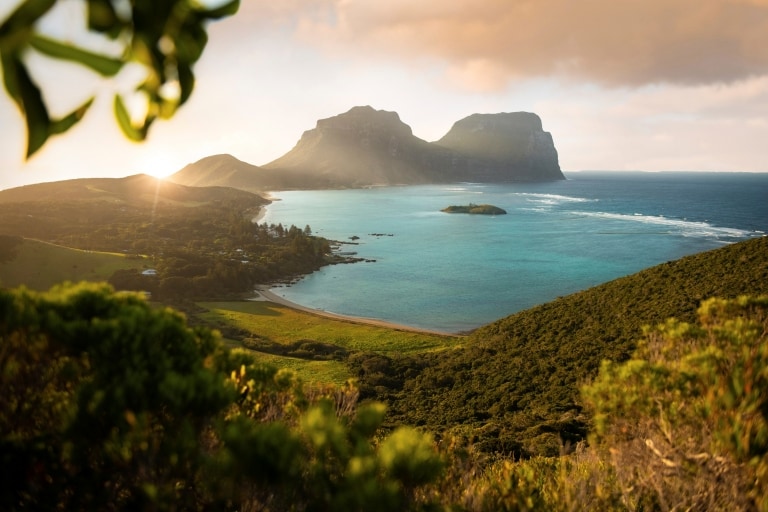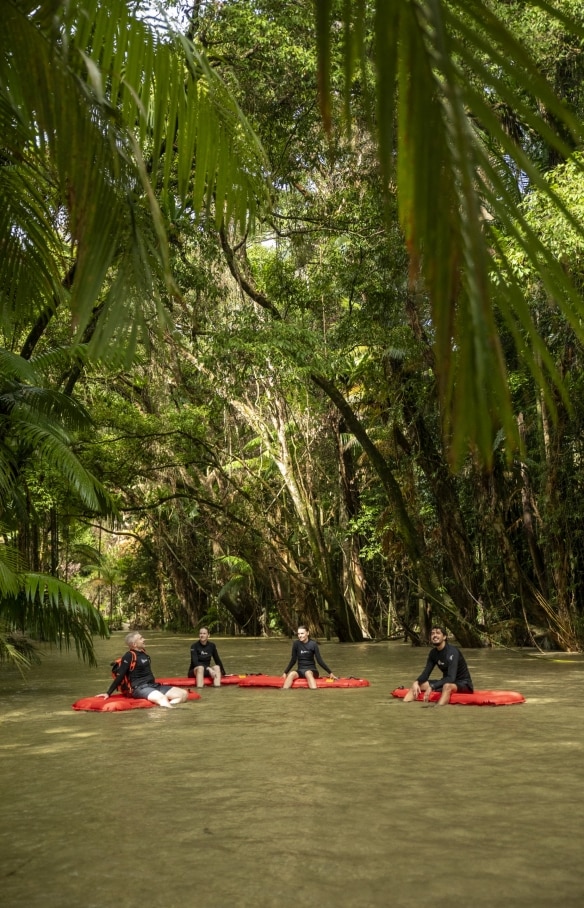
Mount Lidgbird and Mount Gower, Lord Howe Island, New South Wales © Tom Archer
Australia’s most eco-friendly destinations
Connection to nature and sustainable practices at some of our most eco-friendly destinations.
Port Douglas
Port Douglas
Port Douglas in Tropical North Queensland is home to two World Heritage-listed sites – the Daintree Rainforest and the Great Barrier Reef. There are ample sustainable experiences here, but don’t miss the Mossman Gorge Cultural Centre, where you can join a local Kuku Yalanji guide to trek over trickling rainforest streams and learn about traditional environmental protection practices. You can also take to the outer reefs with Climate Action Leaders Sailaway, who offer snorkelling charters that support programs to nurture coral, monitor reef health and offset carbon emissions.
Lord Howe Island
Lord Howe Island
A two-hour flight from Sydney will land you on breathtaking Lord Howe Island. In this natural wonderland, 75 per cent of the island’s vegetation remains intact, a dedicated marine park protects abundant underwater life and a limit of 400 visitors at any one time ensures no overcrowding. The island is a haven for over 130 permanent and migratory bird species, with seabirds nesting here in their hundreds of thousands. Spend time hiking, snorkelling and exploring, or witness the wonderful bird bonanza on a tour with respected nature guide Ian Hutton OAM.
Margaret River
Margaret River
A three-hour drive south of Perth, the Margaret River region has some of Australia’s most exquisite beaches and forests, as well as a thriving wine industry. Visit an integrated farm and winery at Glenarty Road and stay for a long lunch beside the vibrant vegetable garden before joining the Forage on the Farm tour to discover how sheep, pigs, vegetables and grapes can co-exist without pesticides and fertilisers. Over at Passel Estate, you can savour a private nature and wine walk – sipping some of the region’s finest drops as you meander through a bushland sanctuary that acts as a refuge for local possums.
Norfolk Island
Norfolk Island
Just a 2.5-hour flight from Sydney or Brisbane, the remote volcanic outcrop of Norfolk Island stands tall from the depths of the Pacific. Community members on the quaint but picturesque oasis are dedicated to exploring creative sustainable practices to protect the island’s ecosystem, such as converting waste into reusable shopping bags. With no mammals or snakes, this is a place of abundant birds, green farmlands and World Heritage-listed convict sites. Visit the Botanic Gardens and Norfolk Island National Park to see the iconic Norfolk Pines, the Norfolk Island tree fern (the tallest on earth) and the pretty native hibiscus.
Lady Elliot Island
Lady Elliot Island
On the Southern Great Barrier Reef, Lady Elliot Island is a beacon of sustainable practices. Both Eco Certified and Climate Action Certified, Lady Elliot Island Resort runs entirely on renewable energy and actively contributes to revegetation, the removal of invasive species and sustainability education for guests. This is one of the best places in Australia to snorkel with manta rays, and divers can even get involved with a citizen science conservation program called Project Manta. Individual mantas can be identified by the unique markings on their undersides, and divers are encouraged to submit their photographs to help unlock the puzzle of the manta’s life.
Kangaroo Island
Kangaroo Island
Kangaroo Island, just 13km (8mi) off South Australia’s coastline, is a nature lover’s paradise. The coastal haven is famous for its abundant wildlife and thriving eco-conscious food production scene, from pure Ligurian-bee honey to sustainably farmed oysters. Experience this incredible destination on a luxury full-day tour with Exceptional Kangaroo Island to view wildlife in an ethical, non-invasive environment. Gaze in wonder at wild koalas, kangaroos and rare Australian sea lions, then tuck into a private barbeque featuring some of Kangaroo Island’s favourite sustainable produce.
Bruny Island
Bruny Island
With its breathtaking ocean cliffs and rustic farmland, Bruny Island in Tasmania is a southern hotspot for eco-friendly travel. Just a one-hour drive from Hobart, the island is home to marine experiences, organic food producers and all 12 of Tasmania’s endemic birds. Base yourself right in the heart of nature at the Earthcheck-recognised 43 Degrees apartments. Stop in for a tasting at Bruny Island Cheese Co, which treats and recycles its waste water and by-products, then hike and tour the dramatic coastline with Eco-Certified Bruny Island Cruises.
Blue Mountains
Blue Mountains
A short drive west of Sydney, the Blue Mountains offer 2,680 square kilometres (1,035 square miles) of rocky cliffs, canyons, forested valleys, waterfalls and crisp mountain air. Don’t miss the iconic (and Advanced Ecotourism certified) Scenic World, where you can ride the world's steepest railway and hop on an aerial cable car to descend into Jamison Valley. For an added thrill, try Beyond Skyway, where you’ll harness up and climb onto the cable car roof, or choose to stay grounded during an insightful (and sustainable) wander with Tread Lightly Eco Tours.
Mornington Peninsula
Mornington Peninsula
Outside Melbourne, the Mornington Peninsula is a foodie’s delight, with a growing biodynamic food and wine scene that’s ripe for the tasting. Follow the Wine Food Farmgate Trail to sample everything from farm-fresh strawberries to heirloom vegetables. On a day trip, you can taste the region during an Organic and Biodynamic Tour with Mornington Peninsula Plunge Wine Tours. Visit organic vineyards and an organic dairy before indulging in a locally sourced lunch with paired wines. Stay a little longer and take to the ocean with Moonraker Dolphin Swims, who have held Advanced Eco Certification since 1998, to swim with wild seals and dolphins.
Freycinet
Freycinet
Finding eco-friendly destinations in Tasmania is easy, and one of the state’s highlights is the unforgettable Freycinet Peninsula. The region is famous for its breathtaking national park and sustainable oyster industry, and with Oyster Bay Tours, you’ll be immersed in more ways than one. Don the waterproof wading pants and follow your guide out to the oyster farm, where you’ll slurp down the juicy molluscs with a glass of local wine. Bed down for the night at the luxurious and sustainability-conscious Saffire Freycinet.
























































































































































































